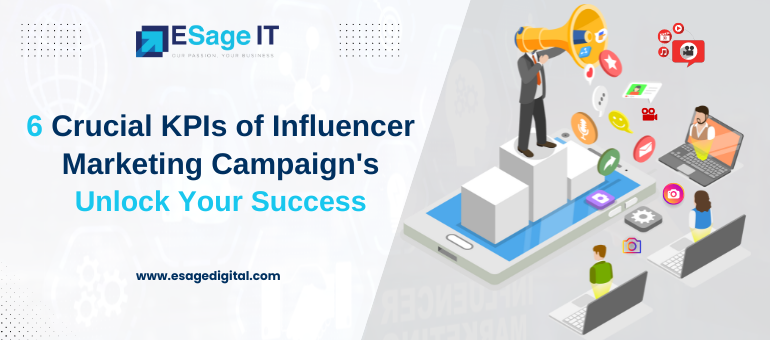- What We Do
-
-
Search Engine Optimization
-
PPC Management
Digital Brand Building
-
Social Media Management
-
E-commerce Digital Marketing
White label
-
-
-
- The Digital Edge
- Info-sphere
- Get Proposal
- Free SEO Audit

Influencer marketing, which uses social media networks to spread word-of-mouth techniques, has become a potent method in the digital era. Now estimated to be worth an astounding $2.1 billion, marketers are utilizing influencers to reach their target audience in a way never possible before.
Influencer marketing no longer solely relies on celebrities. Influencers today come in all different sizes and forms, with follower counts ranging from under 1,000 to over a million. We can classify them as either nano- or macro-influencers. In addition, the widespread adoption of artificial intelligence has streamlined the procedure for locating and working with the appropriate influencers across multiple platforms, including Facebook, YouTube, Instagram, and TikTok.
However, in the middle of all the hype around influencer marketing, how can advertisers assess the success of their efforts? Key performance indicators (KPIs) are crucial measurements that offer valuable insights into the effectiveness and consequences of influencer marketing initiatives. Now let’s examine six key performance indicators (KPIs) that all marketers need to monitor to make sure their influencer efforts are successful.
1. Traffic: Handling Engagement and Reach
One of the most important metrics for assessing the efficacy and reach of your influencer marketing programs is traffic. Marketers may obtain important insights into the exposure and engagement levels generated by their campaigns by examining data like new visitors, total sessions, referral sources, total page views, and time on site. Additionally, tracking traffic patterns might reveal optimization opportunities, including improving landing pages or experimenting with different call-to-action tactics to boost conversion rates.

2. Engagement: Exposing Interaction with the Audience
Traffic gives a broad overview of a campaign’s reach, but engagement gives more detailed information about audience response and involvement. Indicators of how well your material connects with your audience that are measurable include likes, shares, comments, clicks, and video views. Marketers may assess the success of their messaging and content strategy by tracking engagement rates and examining audience interactions. This allows them to refine future campaigns for maximum impact.
Must read: 9 Proven Ways to Get Noticed on Instagram
3. Conversions: Fueling Sales and Growth
The primary objective of any marketing strategy is to increase conversions and promote business expansion. Marketers may assess the precise effect of influencer marketing initiatives on lead generation, sales, and revenue by monitoring conversions. Through the use of tracking tools like landing pages, promo codes, and affiliate links, marketers are able to trace conversions to certain influencer-driven campaigns, which makes it easier to evaluate the return on investment of their campaigns.

4. Brand Sentiment and Awareness: Developing Brand Perception
Influencers have a big impact on how people perceive brands and audiences. Marketers can evaluate their brand’s perception within the influencer’s network by monitoring sentiment and brand awareness data. Through monitoring impression data, social media mentions, and sentiment research, marketers are able to assess how well their influencer collaborations are boosting brand recognition, trust, and affinity within their target markets.
Must read: Ways of Incorporating Short-Form Video into a Digital Marketing Approach
5. Growth Rate of Audience: Fostering Long-Term Engagement
The audience growth rate, which goes beyond reach and awareness, shows how well influencer marketing initiatives may encourage long-term engagement and steadfast commitment among target audiences. In order to evaluate the long-term effects of influencer partnerships on audience acquisition and retention, marketers can track the growth of followers on various social media platforms and email lists. A strong audience growth rate indicates better connections with prospective consumers in addition to expanded reach, which paves the way for long-term business growth.

6. ROI Maximization: Optimizing Marketing Value
Any marketing campaign’s ability to generate a profit ultimately determines how successful it will be. The best indicator of a campaign’s profitability and capacity to produce desired business results is its return on investment (ROI). Marketers can determine the financial viability of their influencer marketing campaigns by comparing the income they receive to the total expenses they incur. Measures like Earned Media Value (EMV), which provide insights into the organic exposure and brand equity produced by influencer engagements, also provide a comprehensive picture of campaign performance.
Must read: 25+ Tools for Social Media That Every Content Creator Needs
Finally, influencer marketing presents a huge opportunity for companies looking to interact with and establish a genuine connection with their target market. Through meticulous monitoring and evaluation of crucial performance metrics, including traffic, engagement, conversions, brand recognition, audience growth rate, and return on investment, marketers can obtain valuable insights to enhance their influencer marketing tactics and produce measurable business outcomes.
In an increasingly competitive digital world, partnering with influencers offers a compelling chance to build meaningful connections, increase brand reach, and create sustained growth. Brands can confidently and precisely navigate the changing influencer marketing landscape and ensure a quantifiable return on their marketing expenditures by utilizing data-driven insights and strategic KPI tracking.
Must read: 15+ Essential SEO Reporting Tools for Agencies